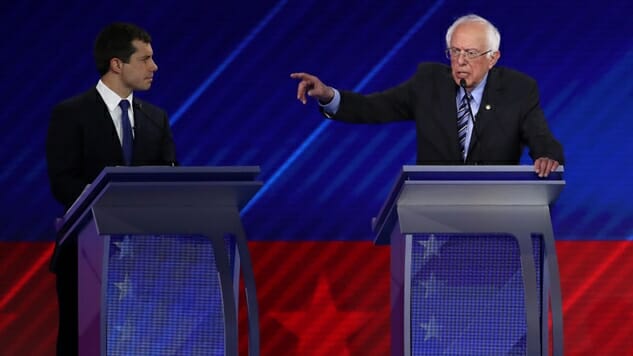Why Pete Buttigieg’s (Cynically Manipulative) Ad Sparked a Thanksgiving Wildfire in the Democratic Party
Photo by Win McNamee/Getty
If someone in your life is urging you to sign up for Twitter and you have resisted their efforts thus far, you have made a provably healthy decision. Twitter is not the complete and total cesspool many too online folks like myself dramatize it to be, and the reason we’re all addicted to it is because it’s the greatest breaking news service in human history that provides you access to experts around the world that most folks wouldn’t otherwise be able to reach—but like anything on the internet—its culture has become imbued with its most vitriolic power users, and not being on Twitter is an objectively good thing for your brain. While all of you so-called normies were enjoying your Thanksgiving meals with your families, you may have noticed some of the younger crowd getting sucked into our phones. It could have been due to a lot of things given how intrinsic these pieces of de facto 2007 magic and wizardry are to our current reality, but if your family is active on Twitter, the odds are very good that their deteriorating psyche around Thanksgiving night was thanks to this bullshit.
New Pete ad in Iowa taking aim at Warren and Bernie over college affordability/debt (but not by name), arguing they’d alienate half the country by insisting it be “free even for the kids of millionaires”. H/t @McCormickJohn
pic.twitter.com/SEAcOdHcAq— Alex Thompson (@AlxThomp) November 29, 2019
This drew out an honest to goodness ideological war in the Democratic Party, wrapped in a turducken of good old fashioned resentment politics. It is not unimportant to draw these ideological lines in the sand, and Chuck Schumer’s potential 2022 primary opponent (too soon?) helpfully explained why this argument should carry very little weight in the Democratic Party if we are to live up to our stated egalitarian ideals.
1. Universal public systems are designed to benefit EVERYBODY! Everyone contributes & everyone enjoys. We don’t ban the rich from public schools, firefighters, or libraries bc they are public goods.
2. Universal systems that benefit everyone are stronger bc everyone’s invested!
— Alexandria Ocasio-Cortez (@AOC) November 29, 2019
5. Lastly, and I can’t believe we have to remind people of this, but it’s GOOD to have classrooms (from pre-k through college!) to be socioeconomically integrated.
Having students from different incomes & backgrounds in the same classroom is good for society & economic mobility.
— Alexandria Ocasio-Cortez (@AOC) November 29, 2019
There are firm policy reasons why paying for college is different from paying for K-12 education, but the spirit of both is the same: tax everyone—especially the rich in a progressive taxation system in order to pay for everyone’s education. Pete Buttigieg isn’t just making the case against paying for everyone’s college, but the spirit of his attack is a traditional Republican-style assault on the very concept of public goods.
-

-

-

-

-

-

-

-

-

-

-

-

-

-

-

-

-

-

-

-

-

-

-

-

-

-

-

-

-

-

-

-

-

-

-

-

-

-

-

-









































